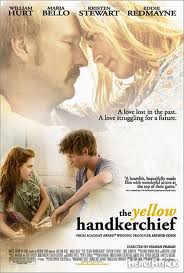Tom Baker reviews cat manga, three new films
Tom Baker (Chiba-ken, 1989-91) is a staff writer for The Daily Yomiuri. He usually writes for DYWeekend, the paper’s arts and leisure section. You can follow Tom’s blog at tokyotombaker.wordpress.com. (One recent post is a cautionary tale for anyone thinking of climbing Mt. Fuji.)
Recently he reviewed the manga “Neko Ramen” and the new-in-Japan films “The Road,” “The Yellow Handkerchief” and “Repo Men.” Here are some excerpts:
“Neko Ramen”
 “It’s the one real maverick cuisine of Japan,” Tokyo ramen shop owner Ivan Orkin told The Daily Yomiuri in an interview last year. Sushi and other cuisines are bound by highly refined conventions, but “ramen is the story of a salaryman whose life sucks and he sells everything and opens a ramen shop…he’s going to do it his own way.”
“It’s the one real maverick cuisine of Japan,” Tokyo ramen shop owner Ivan Orkin told The Daily Yomiuri in an interview last year. Sushi and other cuisines are bound by highly refined conventions, but “ramen is the story of a salaryman whose life sucks and he sells everything and opens a ramen shop…he’s going to do it his own way.”
The manga series Neko Ramen, which made its English-language print debut last month, is about a ramen shop owner named Taisho who almost perfectly embodies the ethos Orkin described.
Taisho isn’t a former salaryman–or a man at all. He’s a cat. But he did buck convention to strike out on his own. His father was a top cat-food advertising model, and it was assumed that Taisho would follow in his glamorous footsteps. Instead, he ran away from home.
Even when he is reduced to living on the street, he never loses his independent spirit. Eventually he discovers his calling as the master of a ramen shop.
Mangaka Kenji Sonishi lives in Sapporo, a city noted for its ramen culture. He has given considerable thought to the most egregious ways a bowl of ramen could go wrong, and he has Taisho stumble into each of them.
Read the rest of the review here.
“The Road”
 …We see this world a decade or so into the aftermath [of a global cataclysm] through the eyes of a father and son (Viggo Mortensen and Kodi Smit-McPhee) who are slowly traveling south on foot, hoping things will get better somewhere along the way.
…We see this world a decade or so into the aftermath [of a global cataclysm] through the eyes of a father and son (Viggo Mortensen and Kodi Smit-McPhee) who are slowly traveling south on foot, hoping things will get better somewhere along the way.
It’s a bleak journey, filmed in such genuinely postapocalyptic locales as hurricane-scoured New Orleans and the blasted slopes of Mt. St. Helens.
One of the film’s most desolate images–which can only be appreciated on the big screen–shows a gigantic highway bridge spanning a valley. Seen from below, the bridge cuts a black swath against the murky gray sky. When the man peers over the side of the bridge, the tiny distant speck that is his head is the only thing in the image to show any movement.
The man and the boy’s long walk is a wire-thin plot onto which brief encounters with varied strangers are strung like widely spaced beads.
At the beginning of most such encounters, the boy wants to befriend and help the person, while the man is suspicious. “Why are you following us?” is his angry refrain, even when the person hasn’t been following them. The middle of every encounter is different, but more than one ends with the pair leaving the person behind, the son worrying that the stranger will die and the father remarking, “He was going to die anyway.”
Often the boy needs to ask, “Are we still the good guys?”…
“The Yellow Handkerchief”
 The Yellow Handkerchief begins almost like a silent movie. The first scene shows a man named Brent (William Hurt) being let out of a prison cell. He hardly says a word, but the other inmates wish him a sincerely friendly farewell. His silence continues outside the walls as he watches other newly released inmates embraced by their waiting families. No one is waiting for him. His face shows that he is resigned, and he sets off down the road on foot, alone.
The Yellow Handkerchief begins almost like a silent movie. The first scene shows a man named Brent (William Hurt) being let out of a prison cell. He hardly says a word, but the other inmates wish him a sincerely friendly farewell. His silence continues outside the walls as he watches other newly released inmates embraced by their waiting families. No one is waiting for him. His face shows that he is resigned, and he sets off down the road on foot, alone.
This tells us a few things about him, and gives us a few things to wonder about.
In the next scene, he is sitting in a small-town diner when he notices a dark-haired teenage girl (Kristen Stewart) outside the window. She walks over to a boy of her own age and speaks to him.
Brent (and we) can’t hear her through the glass, but she stands very close to the boy without looking him in the face, suggesting a mixture of intimacy and shyness. The boy ignores her for a moment and then walks away to smile at a blonde girl who welcomes his attention as if it were her due. The dark-haired girl sees this and heads into the diner with a downcast look, alone.
This tells Brent (and us) a few things about her, and gives us a few things to wonder about.
Read the rest of the review here.
“Repo Men”
 The premise of Repo Men is that in the not too distant future, mechanical hearts, livers, kidneys and other organs are so common that they are sold in shopping malls. But they remain so expensive that you have to take out a scarily high-interest loan to get one. And if you miss a few payments, some even scarier repo men (including a pair played by Jude Law and Forest Whitaker) will find you, Tase you, and gruesomely retrieve the property–which is then rinsed off, repackaged and sold to the next sickly dupe.
The premise of Repo Men is that in the not too distant future, mechanical hearts, livers, kidneys and other organs are so common that they are sold in shopping malls. But they remain so expensive that you have to take out a scarily high-interest loan to get one. And if you miss a few payments, some even scarier repo men (including a pair played by Jude Law and Forest Whitaker) will find you, Tase you, and gruesomely retrieve the property–which is then rinsed off, repackaged and sold to the next sickly dupe.
Theoretically, such a setup could have been used to send an allegorical message about the world’s various debt crises or the U.S. health care debate, but the plot is just a heap of sci-fi action cliches.
First, evil corporations control everything. Second, new technology improves material standards of living, but leaves people shallow and soulless. Third, those who oppose or question the new order are fated to live in refugee camps or slums. Fourth, a hunter becomes the hunted, joins the people he once oppressed and does battle against his former colleagues. Fifth, the ending…

